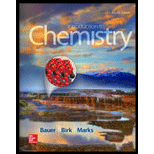
Concept explainers
(a)
Interpretation:
The volume of
(a)
Explanation of Solution
The balanced chemical equation is,
The moles of
From the balanced
The relationship between molarity, moles of solute, and volume of the solution is,
Equation
The volume of
The required volume is in litera and is converted into milliliters.
Hence,
(b)
Interpretation:
The volume of
(b)
Explanation of Solution
The balanced chemical equation is,
The moles of
From the balanced chemical reaction, it is clear that
The relationship between molarity, moles of solute, and the volume of the solution is,
Equation
The volume of
The required volume in liter unit is very small and is converted into milliliters.
Hence,
(c)
Interpretation:
The volume of
(c)
Explanation of Solution
The balanced chemical equation is,
The moles of
From the balanced chemical reaction, it is clear that
The relationship between molarity, moles of solute, and volume of the solution is,
Equation
The volume of
The required volume in liter unit is very small and is converted into milliliter.
Hence,
Want to see more full solutions like this?
Chapter 11 Solutions
Introduction to Chemistry
- ssume a highly magnified view of a solution of HCI that allows you to “see” the HCl. Draw this magnified view. If you dropped in a piece of magnesium, the magnesium would disappear, and hydrogen gas would he released. Represent this change using symbols for the elements, and write the balanced equation.arrow_forwardDescribe in words how you would prepare pure crystalline AgCl and NaNO3 from solid AgNO3 and solid NaCl.arrow_forwardWhat volume of 0.250 M HCI is required to neutralize each of the following solutions? a. 25.0 mL of 0.103 M sodium hydroxide, NaOH b. 50.0 mL of 0.00501 M calcium hydroxide, Ca(OH)2 c. 20.0 mL of 0.226 M ammonia, NH3 d. 15.0 mL of 0.0991 M potassium hydroxide, KOHarrow_forward
- What mass of oxalic acid, H2C2O4, is required to prepare 250. mL of a solution that has a concentration of 0.15 M H2C2O4?arrow_forwardHeme, obtained from red blood cells, binds oxygen, O2. How many moles of heme are there in 150 mL of 0.0019 M heme solution?arrow_forwardWhat volume of 0.0521 M Ba(OH)2 is required to neutralize exactly 14.20 mL of 0.141 M H3PO4? Phosphoric acid contains three acidic hydrogens.arrow_forward
- Oranges and grapefruits are known as citrus fruits because their acidity comes mainly from citric acid, H3C6H5O7. Calculate the concentration of citric acid in a solution if a 30.00-mL sample is neutralized by 15.10 mL of 0.0100 M KOH. Assume that three acidic hydrogens of each citric acid molecule are neutralized in the reaction.arrow_forwardA 25.0-mL sample of sodium sulfate solution was analyzed by adding an excess of barium chloride solution to produce barium sulfate crystals, which were filtered from the solution. Na2SO4(aq)+BaCl2(aq)2NaCl(aq)+BaSO4(s) If 5.719 g of barium sulfate was obtained, what was the molarity of the original Na2SO4 solution?arrow_forwardThe molarity of iodine in solution can be determined by titration with arsenious acid, H3AsO4. The unbalanced equation for the reaction is H3AsO3(aq)+I2(aq)+H2O2 I(aq)+H3AsO4(aq)+2 H+(aq)A 243-mL solution of aqueous iodine is prepared by dissolving iodine crystals in water. A fifty-mL portion of the solution requires 15.42 mL of 0.134 M H3AsO3 for complete reaction. What is the molarity of the solution? How many grams of iodine were added to the solution?arrow_forward
 Introductory Chemistry: A FoundationChemistryISBN:9781337399425Author:Steven S. Zumdahl, Donald J. DeCostePublisher:Cengage Learning
Introductory Chemistry: A FoundationChemistryISBN:9781337399425Author:Steven S. Zumdahl, Donald J. DeCostePublisher:Cengage Learning
 Chemistry: An Atoms First ApproachChemistryISBN:9781305079243Author:Steven S. Zumdahl, Susan A. ZumdahlPublisher:Cengage Learning
Chemistry: An Atoms First ApproachChemistryISBN:9781305079243Author:Steven S. Zumdahl, Susan A. ZumdahlPublisher:Cengage Learning ChemistryChemistryISBN:9781305957404Author:Steven S. Zumdahl, Susan A. Zumdahl, Donald J. DeCostePublisher:Cengage Learning
ChemistryChemistryISBN:9781305957404Author:Steven S. Zumdahl, Susan A. Zumdahl, Donald J. DeCostePublisher:Cengage Learning Chemistry: Principles and PracticeChemistryISBN:9780534420123Author:Daniel L. Reger, Scott R. Goode, David W. Ball, Edward MercerPublisher:Cengage Learning
Chemistry: Principles and PracticeChemistryISBN:9780534420123Author:Daniel L. Reger, Scott R. Goode, David W. Ball, Edward MercerPublisher:Cengage Learning Chemistry by OpenStax (2015-05-04)ChemistryISBN:9781938168390Author:Klaus Theopold, Richard H Langley, Paul Flowers, William R. Robinson, Mark BlaserPublisher:OpenStax
Chemistry by OpenStax (2015-05-04)ChemistryISBN:9781938168390Author:Klaus Theopold, Richard H Langley, Paul Flowers, William R. Robinson, Mark BlaserPublisher:OpenStax





